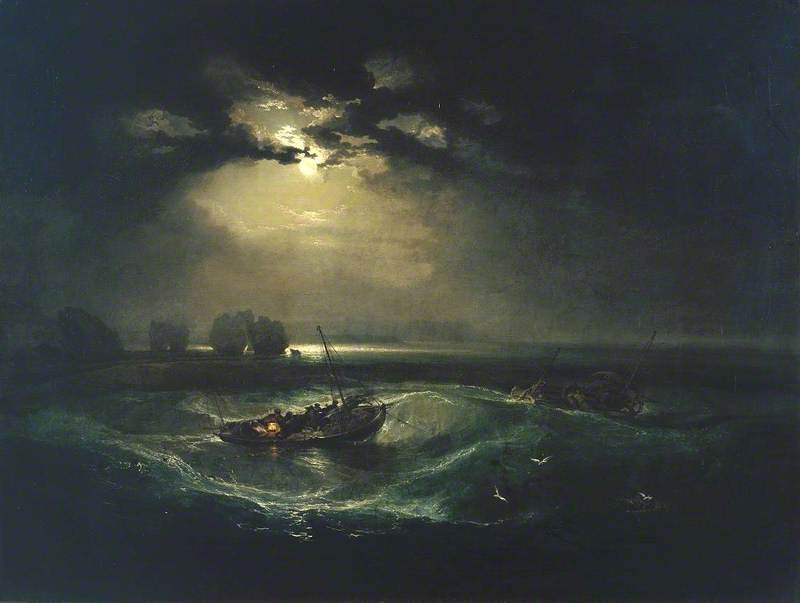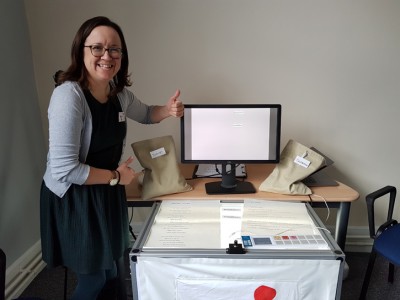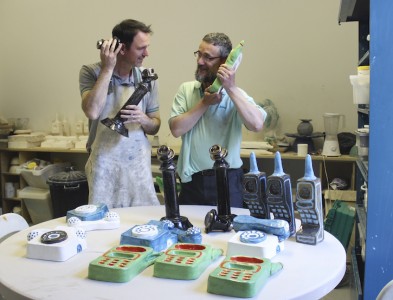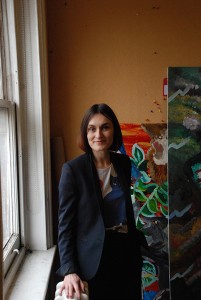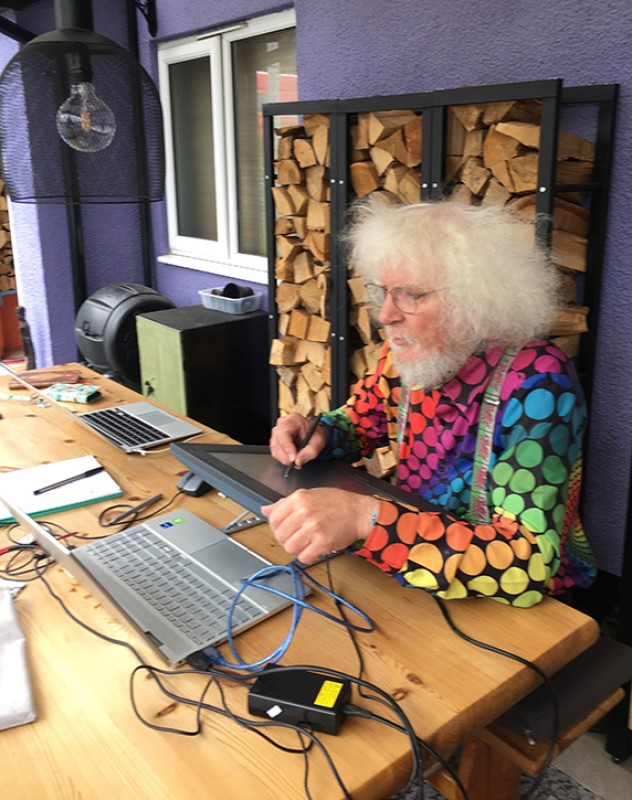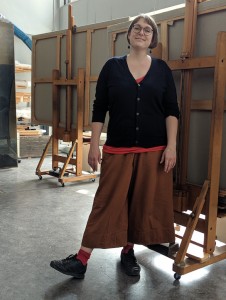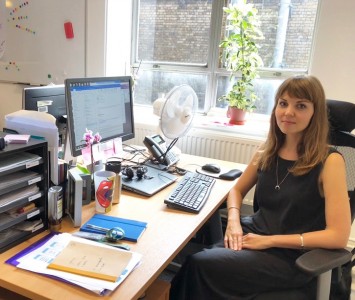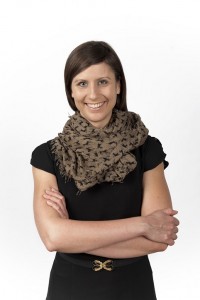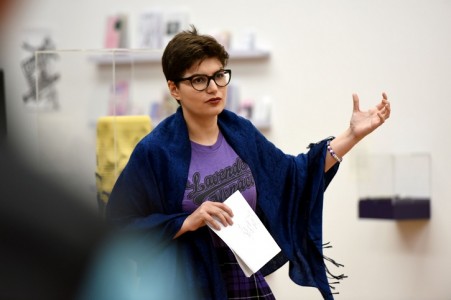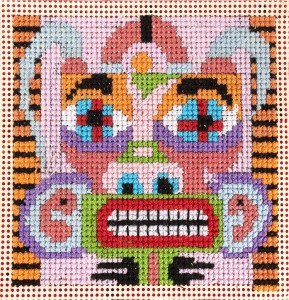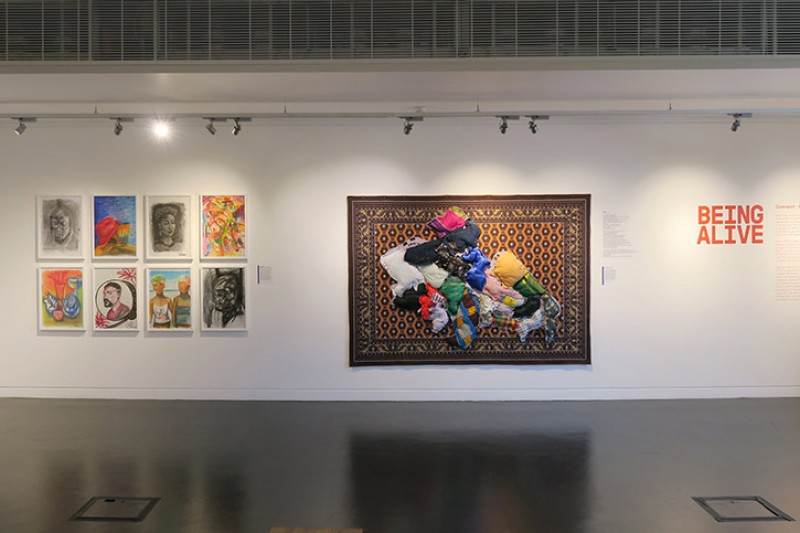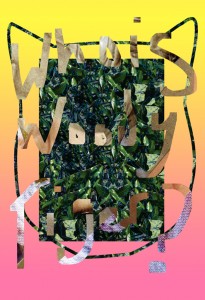For Art UK's 'Being...' series, we take a look at a day in the life of a professional working in the arts, heritage or museum sector, or more broadly within visual culture.
This interview was conducted over video call and transcribed and edited into text format.
Mark with a bedroom wall mural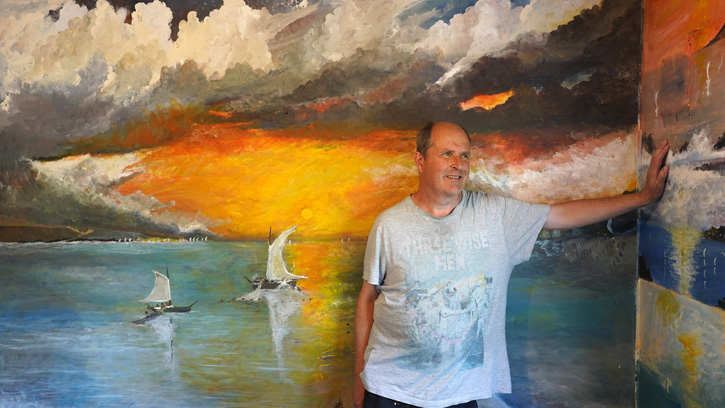
What do you do?
I'm Mark Noble, a creative artist from Somerset. I am from what is called the 'old school' of art. I like to paint in the style of J. M. W. Turner, which is a romanticised but realistic style. I am also a modern painter, doing abstract and Cubist sort of work.
On a typical day – aside from doing normal things like spending time with grandchildren – my work as an artist also involves meeting people and doing interviews. I do a lot of social media and try to be creative as possible.
I'm also an ambassador for the charity Outside In and I do work for SANE. My personal take is that art is really important for people – for their mental health and for communication.
Recovery
painting by Mark Noble 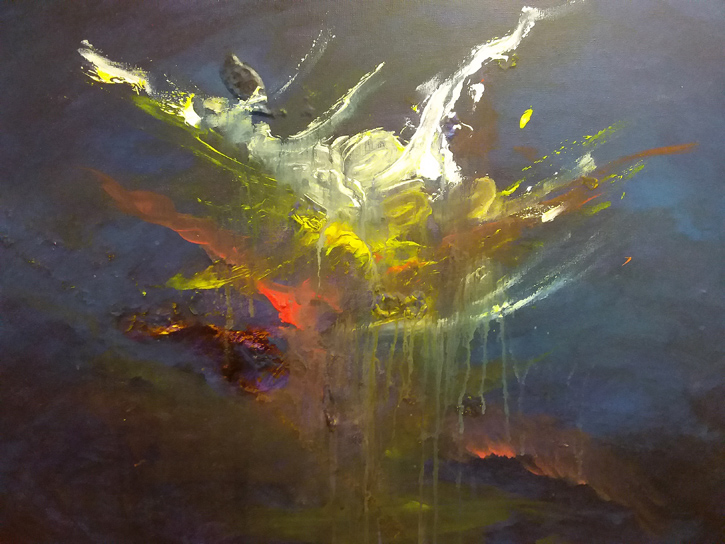
When did you start painting?
When I was five years old, at school, teachers said I had talent. I've been an artist on and off, working in between jobs, being married and having a family. I've been a funeral director and worked in gardens, been a chef and also worked in a plastics factory. Now I am a full-time practitioner in art.
I think my artistic style changed when I went to London. I went to the National Portrait Gallery and The National Gallery and saw Turner's work, and work by Constable, Degas, Claude Monet, and Frederic Edwin Church, these really fantastic painters. I saw how they used and manipulated light and that really inspired me. But I've always had a love of the natural world – especially weather and weather-related art.
Does where you live influence your art?
I live in Glastonbury. Glastonbury has got a different way of seeing the world. Somerset is a beautiful county to live in. We've got the Bristol Channel: the actual sea is about 15 or 20 miles to the west of us, and there are lakes and nature reserves – an eclectic range of different ways of seeing water: floods, rivers, streams, waterfalls. Nearby are Exmoor, Dartmoor and the Mendips, Blackdowns, and Malvern Hills, different landscapes.
Bay of Moonlight
painting by Mark Noble 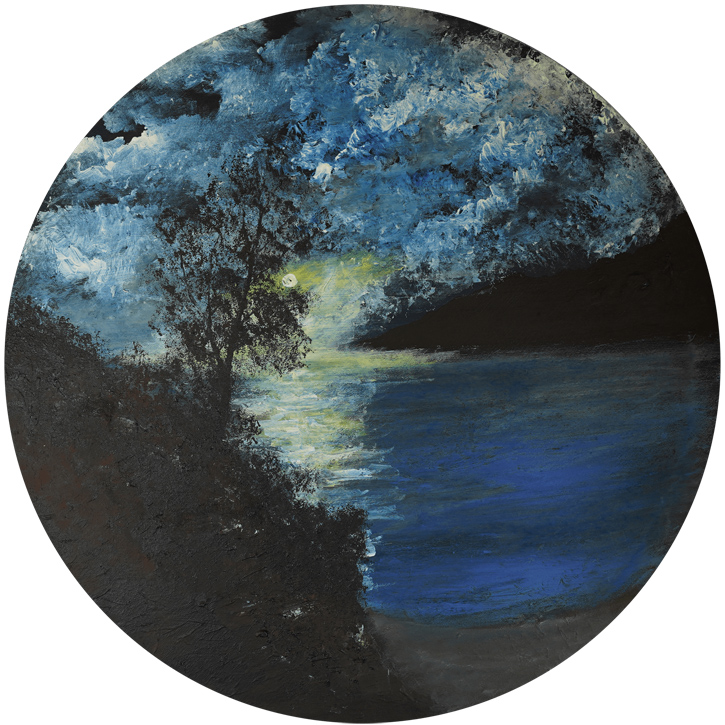
Can you explain more about your artistic process?
The scenes I paint are from a mixture of real life and my own creative mind. If you have a thought in your head, gradually an idea will develop, and you can transfer that onto canvas. When I've got an idea in my head, I do some sketches and I mull over it for three or four days until I've got a clearer vision. Then I will sketch the image onto the canvas, maybe using pencils, then I would start putting the paint on in layers of washes.
First of all, I would cover the canvas with a warm colour. Then I'll gradually add layer upon layer. Sometimes I use a wide range of tools to get the desired effects. I've worked in egg tempera, oil, watercolour and acrylic – but I prefer acrylics as they dry quickly. A painting can take from 15 minutes to three or four months.
I got a show at Bishop's Palace in Wells coming up. I'm using a lot of recycled materials – I think the environment is really important. I did a painting that is recyclable: I buy a frame from a charity shop and use the wood. I'm using different materials like metal, and painting on different surfaces.
Mark at Bishop's Palace, Wells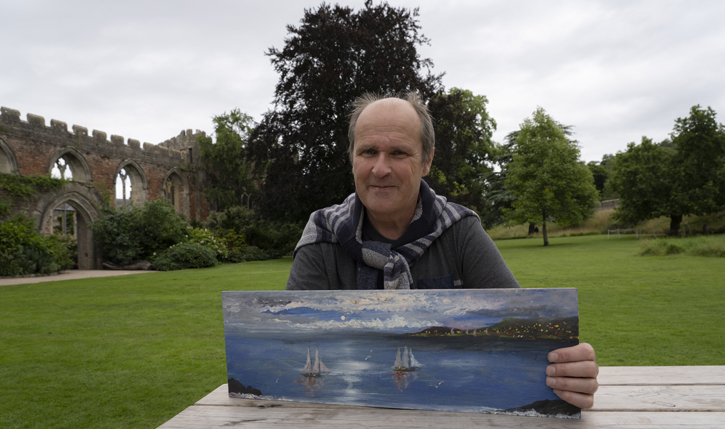
Do you have a studio at home or do you travel to work?
I will if I'm teaching. I like teaching, such as in forest schools, and I've worked with charities, like Children's World – we do workshops when the weather is better. I have a studio in the bedroom but I paint anywhere I want to paint – sometimes I paint on the cooker!
What other work goes into being an artist?
For the administrative side, I've got an agent who will help me and an assistant who does paperwork and helps me with emails. That's the biggest stumbling block: making sure what you're doing is coming across as professional. My website is a main focus – so people can see the work available to buy.
I met a client today to make sure he liked the work – because it's got to hang on his wall and not my wall. It's a bit nerve-wracking to me, as it's a very different experience, seeing a painting on LinkedIn, and seeing it in real life. But at the end of the day, he loved the painting, and I enjoyed chatting. So that took about two hours, but it's essential – you've got to have a proper working practice.
Driftwood
painting by Mark Noble 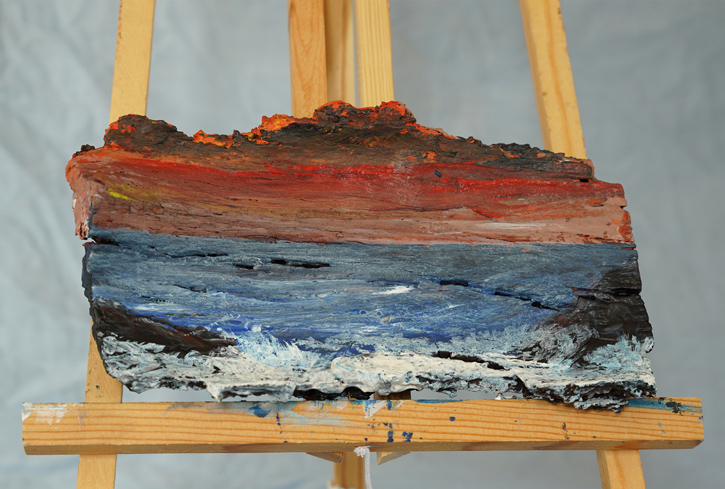
Do you find painting meditative or calming?
Because I'm severely dyslexic, I use art as a visual language. The written word for me would be impossible. I can't read and write well but I find art an easier medium in which to explain myself. I never find art stressful. People ask if I get artist's block, like writer's block, but I never suffer from that. I love and enjoy what I'm doing: if it doesn't work the first time, you try and try again. There's so much to paint, and so many different creative people to chat to, as well as teaching and celebrating the arts.
What is it about Turner's work that really speaks to you?
It's eternal, the light these artists use and the light I use, and I think it's something magical. For me, it's quite spiritual. It's not religious but you touch on something sublime, or something which you can see, you can feel, but you can only grasp a small part of. A simple tube of paint can make something magical.
I did a painting once, at an art class or art gallery, and a woman came up, she was from Margate. She burst into tears when she saw my painting. I said to her, 'it can't be that bad!' She explained the colours of the setting sun triggered a childhood memory. My picture brought back to life that memory in her own mind.
It's such talent to replicate nature like that – it's baffling how you capture snow and moonlight in your paintings.
Snow's not white because the snow will absorb all the colours around it. And I never use black because black will kill a canvas. I use dark greys, purples, reds, greens and oranges to create that blackness. White reflects colour, black absorbs colour and it will make your painting go flat. Obviously, black is a colour but, in art, black and white are not seen as colours – I don't make up the rules on that one!
Moonlight Over Lake
painting by Mark Noble 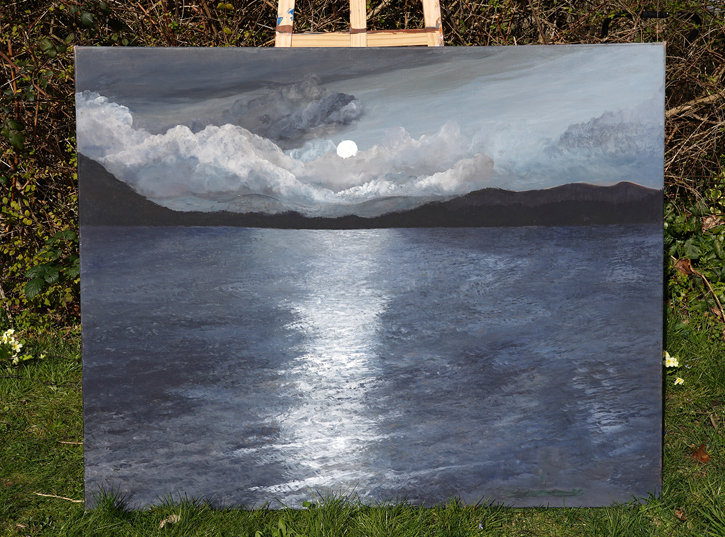
What do you do in your role as Ambassador at Outside In?
Sometimes we have meetings, talk about art and meet different artists. For example, we've got a Zoom meeting coming up where I'll choose 10 images and talk about them. My role is promoting the charity to different organisations, in this country and abroad. It's all about promoting disabilities and creating opportunities for artists in my situation. I try to explain that to a much bigger audience.
I don't think there should be any barriers to art. Obviously there's a limit to what people can do, but I think art should be open to every kind of person. Charities like Outside In, Shape Arts and DASH will give opportunities: if you're a severely dyslexic or severely disabled artist, they will try their best. My philosophy for art is that everybody should have a go at it, enjoy it, be creative and see where it leads. We live in a wonderful, creative world and it's nice meeting different, creative people. Hopefully that's a good way of seeing things.
I'm doing some work for SANE at the moment – they work with adults with mental health issues, their work is very important. Art can play a massive role. I've got a good relationship with them. I'm autistic myself. I think it gives me a unique situation.
In the 1970s, I went to a specialist school. Dyslexia and the autism spectrum: in the 1970s and early 1980s, a lot of it wasn't understood. Learning was difficult and you would be called names like 'thicko' or 'stupid' and other things I won't pronounce! But now there is better understanding and much, much better tolerance and people like Shape and DASH – the people I work for – they're there to help promote a better understanding.
Crashing Waterfall
painting by Mark Noble 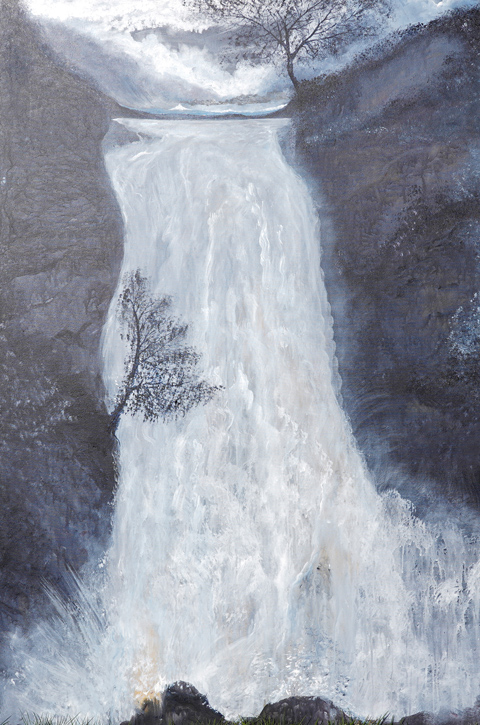
It's about having that understanding. With the pandemic, I think art is going to play a bigger role in people's lives. It's not a wonder cure but it can – and it does – help. It helps people to put their feelings into painting. I think they could do a lot more with the arts – stop cutting everything and put more money into the creative industries and our rewards will be brilliant – it would make the world a better place.
Mark Noble, artist
More about Mark and his artwork can be found on his website: www.MarkNoble.art
Do you work in the arts, heritage or museum sector? Would you be kind enough to share an example of your working day for our 'Being...' series? Please get in touch with Art UK at pitches@artuk.org as we'd love to hear from you.
